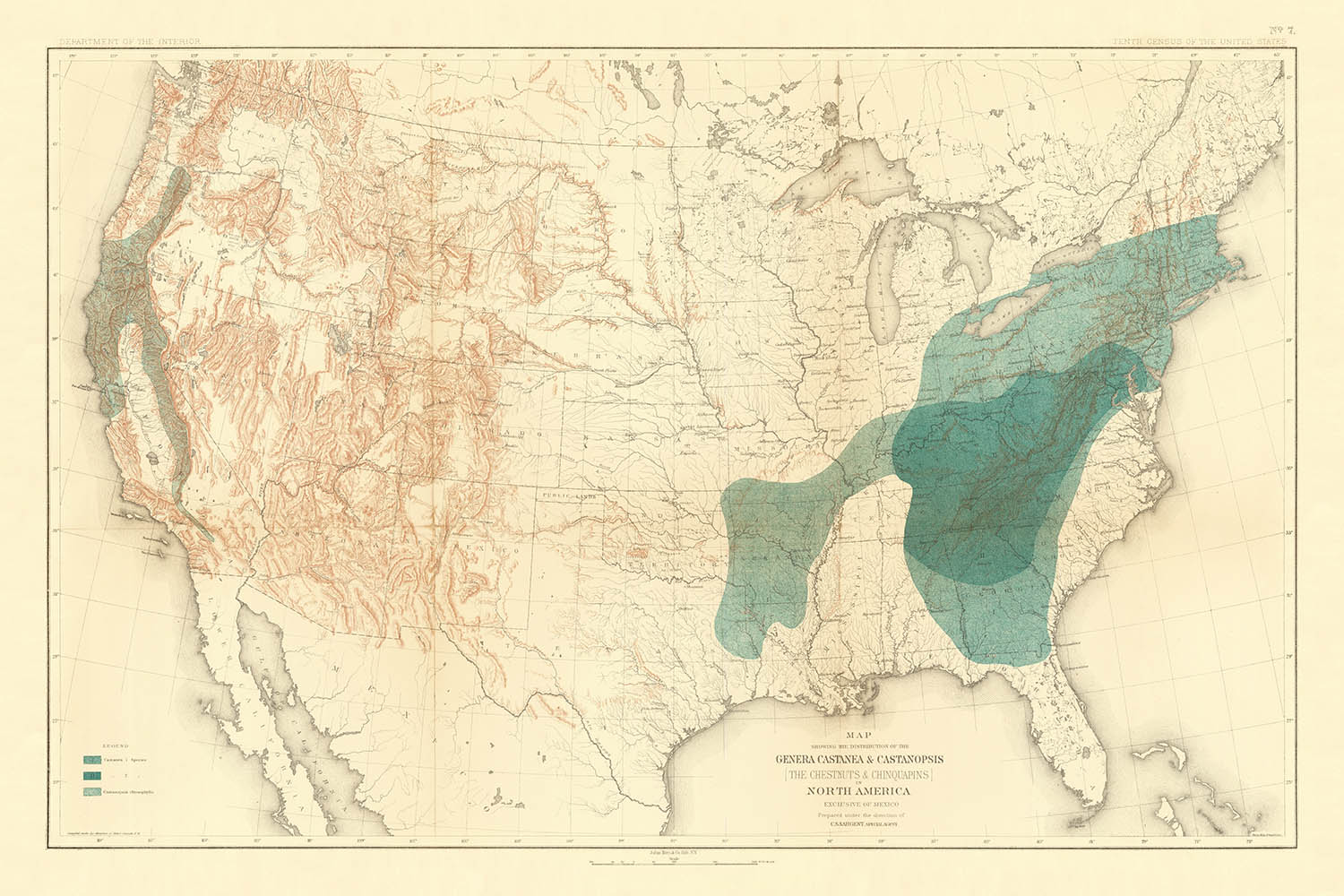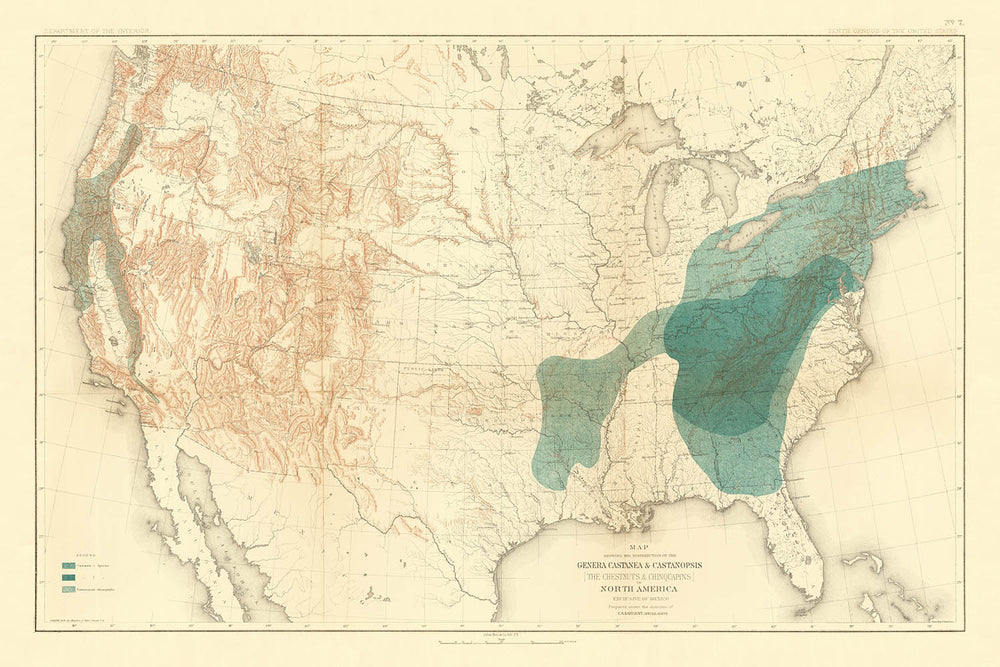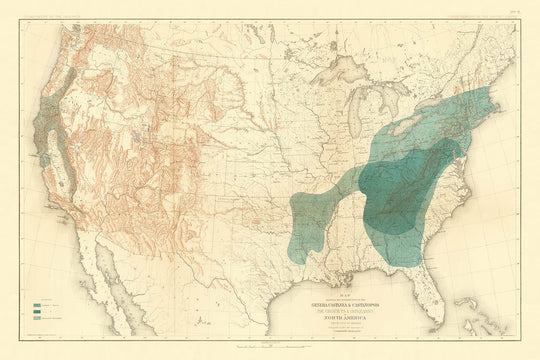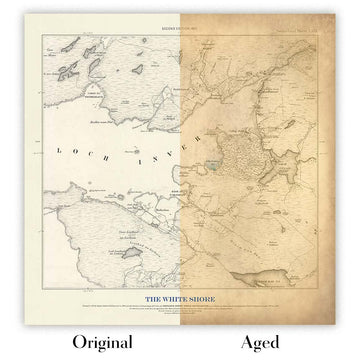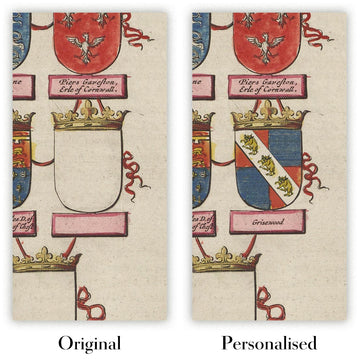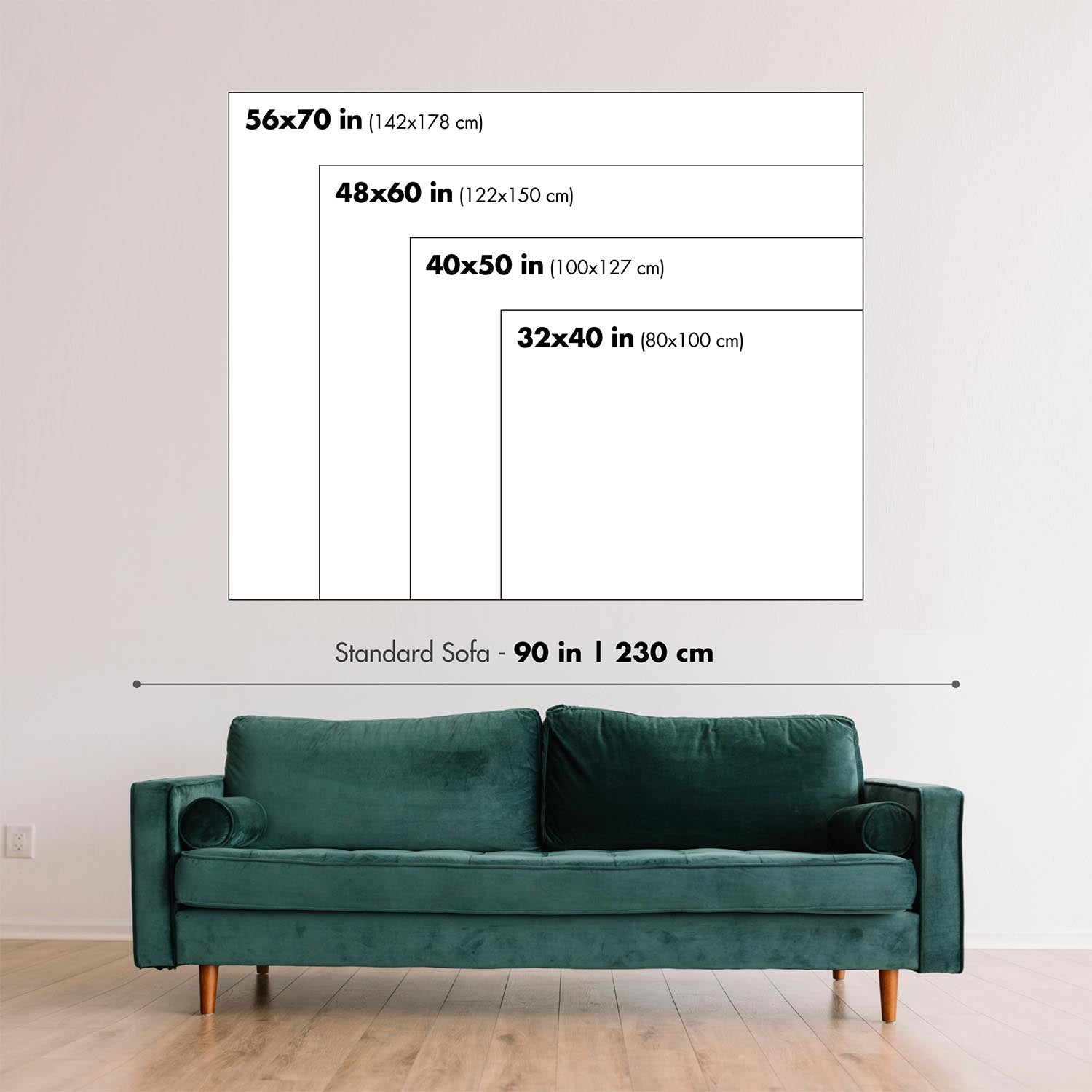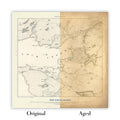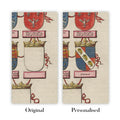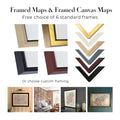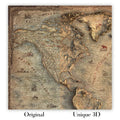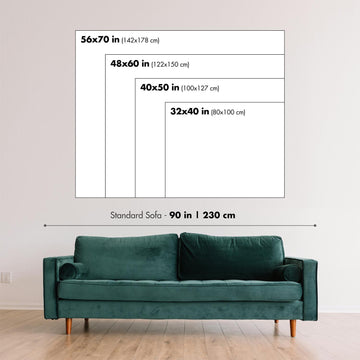- Handmade locally. No import duty or tax
- FREE Delivery by Christmas
- Love it or your money back (90 days)
- Questions? WhatsApp me any time
Own a piece of history
5,000+ 5 star reviews


Step into the rich tapestry of North American botanical history with the "Map Showing the Distribution of the Genera Castanea & Castanopsis (The Chestnuts & Chinquapins) in North America Exclusive of Mexico," a masterwork prepared under the direction of C.S. Sargent for the Tenth Census of the United States in 1884. This remarkable thematic map is more than a scientific document—it is a vivid snapshot of a landscape before the devastation of the American chestnut, capturing the native range of chestnuts and chinquapins at a pivotal moment in ecological history. The map’s careful delineation of these genera’s habitats reveals the profound relationship between geography and the continent’s once-abundant hardwood forests.
Produced by the renowned Julius Bien & Co., this map is a testament to the era’s finest color-lithographic techniques. Julius Bien, a luminary in American cartography and lithography, brought scientific precision and artistic elegance to every project. His firm was celebrated for its collaborations with leading scientists and government agencies, making this map not only a functional resource but also a collector’s treasure. The involvement of draughtsman Harry King and compiler Henry Gannett—both pivotal figures in American mapping—ensures the highest standards of accuracy and detail.
The map’s thematic focus on the distribution of Castanea and Castanopsis sets it apart as a unique artifact of environmental and economic history. At a time when the American chestnut was a keystone species in eastern forests, this map provided critical insight for botanists, foresters, and policymakers. The shaded regions, meticulously rendered, chart the natural ranges of these trees across the eastern United States, with particular density along the Appalachian Mountains and the Atlantic seaboard. These visual cues invite the viewer to explore the interplay between topography, climate, and botanical diversity.
Geographically, the map offers a comprehensive view of the United States, with state and county boundaries crisply outlined to provide a sense of scale and place. Major rivers, such as the mighty Mississippi and its tributaries, flow through the landscape, echoing the routes of exploration and commerce that shaped the nation. The Appalachian Mountains rise prominently within the chestnut’s range, their contours subtly shaded to reflect both elevation and ecological significance. The Atlantic coastline, with its gentle curves, frames the eastern extent of these storied woodlands.
What sets this map apart is its singular focus on the natural world, eschewing the clutter of cities and towns in favor of pure ecological storytelling. There are no urban centers or settlements to distract from the botanical narrative; instead, the viewer’s eye is drawn to the grand sweep of nature itself. As a piece of scientific cartography, it stands as both a work of art and a historical document—an enduring reminder of a lost landscape and the enduring legacy of the cartographers and botanists who sought to understand it.
Cities and towns on this map
- No cities or towns are labelled or marked on this map. The map is focused on botanical distribution and does not include human settlements.
Notable Features & Landmarks
- Distribution shading: Areas of the United States are shaded or colored to show the natural range of chestnuts and chinquapins.
- State boundaries: Clearly marked throughout the United States.
- County boundaries: Visible in some states, providing finer geographic detail.
- Major rivers: Several large rivers are depicted, including the Mississippi River and its tributaries.
- The Appalachian Mountains: The range is indicated by shading and topographic lines, as this region is significant for chestnut distribution.
- The Atlantic coastline: Clearly delineated, as the distribution of chestnuts extends along this area.
- Borders: The U.S.-Canada border is shown, as well as the southern border with Mexico (though Mexico is excluded from the mapped area).
Historical and design context
- Name of the map: Map Showing the Distribution of the Genera Castanea & Castanopsis (The Chestnuts & Chinquapins) in North America Exclusive of Mexico.
- Date created: 1884.
- Mapmaker/publisher: Julius Bien & Co., a prominent American lithography and mapmaking firm in the 19th century, known for high-quality color lithographs and significant contributions to scientific and government publications.
- Prepared under the direction of C.S. Sargent, Special Agent, with draughting by Harry King and compilation by Henry Gannett, both notable figures in American cartography and census work.
- Created for: The Tenth Census of the United States (1880), reflecting the era's focus on documenting natural resources and scientific data.
- Type of map: Country Thematic map, specifically showing botanical/geographical distribution.
- Topics/themes: Distribution of chestnuts (Castanea) and chinquapins (Castanopsis) in North America, excluding Mexico; highlights the natural range of these tree genera.
- Design/style: Color-lithographed, with thematic shading or coloring to indicate the distribution areas of the tree genera; typical of late 19th-century scientific mapping.
- Historical significance: Reflects the importance of chestnut and chinquapin species in North American forestry, ecology, and economy before the devastation caused by chestnut blight in the 20th century; part of a broader movement to scientifically document the continent’s flora.
- Contextual note: The map is an example of early scientific cartography in the United States, produced for a federal census, and illustrates the collaboration between botanists, cartographers, and lithographers.
Please double check the images to make sure that a specific town or place is shown on this map. You can also get in touch and ask us to check the map for you.
This map looks great at every size, but I always recommend going for a larger size if you have space. That way you can easily make out all of the details.
This map looks amazing at sizes all the way up to 100in (250cm). If you are looking for a larger map, please get in touch.
Please note: the labels on this map are hard to read if you order a map that is 20in (50cm) or smaller. The map is still very attractive, but if you would like to read the map easily, please buy a larger size.
The model in the listing images is holding the 24x36in (60x90cm) version of this map.
The fifth listing image shows an example of my map personalisation service.
If you’re looking for something slightly different, check out my collection of the best old maps to see if something else catches your eye.
Please contact me to check if a certain location, landmark or feature is shown on this map.
This would make a wonderful birthday, Christmas, Father's Day, work leaving, anniversary or housewarming gift for someone from the areas covered by this map.
This map is available as a giclée print on acid free archival matte paper, or you can buy it framed. The frame is a nice, simple black frame that suits most aesthetics. Please get in touch if you'd like a different frame colour or material. My frames are glazed with super-clear museum-grade acrylic (perspex/acrylite), which is significantly less reflective than glass, safer, and will always arrive in perfect condition.
This map is also available as a float framed canvas, sometimes known as a shadow gap framed canvas or canvas floater. The map is printed on artist's cotton canvas and then stretched over a handmade box frame. We then "float" the canvas inside a wooden frame, which is available in a range of colours (black, dark brown, oak, antique gold and white). This is a wonderful way to present a map without glazing in front. See some examples of float framed canvas maps and explore the differences between my different finishes.
For something truly unique, this map is also available in "Unique 3D", our trademarked process that dramatically transforms the map so that it has a wonderful sense of depth. We combine the original map with detailed topography and elevation data, so that mountains and the terrain really "pop". For more info and examples of 3D maps, check my Unique 3D page.
Para la mayoría de los pedidos, el tiempo de entrega es de aproximadamente 3 días laborables. Los productos personalizados y a medida tardan más, ya que tengo que hacer la personalización y enviártelo para su aprobación, lo cual suele tardar 1 o 2 días.
Tenga en cuenta que los pedidos enmarcados muy grandes suelen tardar más en fabricarse y entregarse.
Si necesitas que tu pedido llegue para una fecha determinada, por favor contáctame antes de hacer el pedido para que podamos encontrar la mejor manera de asegurarnos de que recibas tu pedido a tiempo.
Imprimo y enmarco mapas y obras de arte en 23 países alrededor del mundo. Esto significa que tu pedido se fabricará localmente, lo que reduce el tiempo de entrega y asegura que no se dañe durante el envío. Nunca pagarás aranceles de aduana o impuestos de importación, y pondremos menos CO2 en el aire.
Todos mis mapas y impresiones artísticas están bien empaquetados y enviados en un tubo resistente si no están enmarcados, o rodeados de espuma si están enmarcados.
Intento enviar todos los pedidos dentro de 1 o 2 días después de recibir tu pedido, aunque algunos productos (como mascarillas, tazas y bolsas de tela) pueden tardar más en fabricarse.
Si seleccionas Entrega Exprés al finalizar la compra, priorizaremos tu pedido y lo enviaremos por mensajería de 1 día (Fedex, DHL, UPS, Parcelforce).
La entrega al día siguiente también está disponible en algunos países (EE. UU., Reino Unido, Singapur, EAU), pero por favor intenta hacer tu pedido temprano en el día para que podamos enviarlo a tiempo.
Mi marco estándar es un marco de madera de fresno negro estilo galería. Es simple y tiene un aspecto bastante moderno. Mi marco estándar tiene alrededor de 20 mm (0.8 in) de ancho.
Utilizo acrílico super claro (perspex/acrylite) para el vidrio del marco. Es más ligero y seguro que el vidrio, y se ve mejor, ya que la reflectividad es menor.
Seis colores de marco estándar están disponibles de forma gratuita (negro, marrón oscuro, gris oscuro, roble, blanco y oro antiguo).El enmarcado y montaje/matizado personalizado está disponible si buscas algo diferente.
La mayoría de los mapas, arte e ilustraciones también están disponibles como un lienzo enmarcado. Utilizamos lienzo de algodón mate (no brillante), lo estiramos sobre un marco de madera de caja de origen sostenible, y luego 'flotamos' la pieza dentro de un marco de madera. El resultado final es bastante hermoso, y no hay cristal que se interponga.
Todos los marcos se proporcionan "listos para colgar", con una cuerda o soportes en la parte posterior. Los marcos muy grandes tendrán placas de colgar de alta resistencia y/o un listón de montaje. Si tienes alguna pregunta, por favor ponte en contacto.
Mira algunos ejemplos de mis mapas enmarcados y mapas en lienzo enmarcados.
Alternativamente, también puedo proporcionar mapas antiguos y obras de arte en lienzo, tablero de espuma, papel de algodón y otros materiales.
Si deseas enmarcar tu mapa o obra de arte tú mismo, por favor lee mi guía de tamaños primero.
Algunos de mis mapas antiguos ahora están disponibles como lienzos enmarcados. Por favor contáctame si deseas pedir un tamaño que no está disponible en mi tienda.
Los mapas antiguos en lienzo son una alternativa interesante a los mapas enmarcados convencionalmente. Dependiendo de tu gusto personal y la decoración de la habitación, los mapas en lienzo pueden "destacar" un poco más que un mapa enmarcado.
Mis mapas son reproducciones de mapas originales de altísima calidad.
Obtengo mapas originales y raros de bibliotecas, casas de subastas y colecciones privadas de todo el mundo, los restauro en mi taller de Londres y luego uso tintas e impresoras giclée especializadas para crear hermosos mapas que lucen incluso mejor que el original.
Mis mapas están impresos en papel de archivo mate (no brillante) sin ácido que se siente de muy alta calidad y casi como una tarjeta. En términos técnicos, el peso/grosor del papel es de 10 mil/200 g/m². Es perfecto para enmarcar.
Imprimo con tintas pigmentadas Epson ultrachrome giclée UV resistentes a la decoloración, algunas de las mejores tintas que puedes encontrar.
yo también puedo hacer mapas sobre lienzo, trapo de algodón y otros materiales exóticos.
Obtenga más información sobre The Unique Maps Co..
Personalización de mapas
Si está buscando el regalo perfecto de aniversario o inauguración de la casa, puedo personalizar su mapa para hacerlo verdaderamente único. Por ejemplo, puedo agregar un mensaje corto, resaltar una ubicación importante o agregar el escudo de armas de su familia.
Las opciones son casi infinitas. Por favor mira mi página de personalización de mapas para ver algunos maravillosos ejemplos de lo que es posible.
Para pedir un mapa personalizado, seleccione "personalizar su mapa" antes de agregarlo a su carrito.
Ponerse en contacto si buscas personalizaciones y personalizaciones más complejas.
Envejecimiento del mapa
A lo largo de los años, los clientes me han preguntado cientos de veces si podían comprar un mapa que se viera uniforme. más viejo.
Bueno, ahora puedes hacerlo seleccionando Envejecido antes de agregar un mapa a tu carrito.
Todas las fotografías de productos que ve en esta página muestran el mapa en su forma original. Así es como se ve el mapa hoy.
Si selecciona Envejecido, envejeceré su mapa a mano, usando un proceso especial y único desarrollado a través de años de estudiar mapas antiguos, hablar con investigadores para comprender la química del envejecimiento del papel y, por supuesto... ¡mucha práctica!
Si no estás seguro, quédate con el color original del mapa. Si quieres algo un poco más oscuro y más viejo buscando, opte por Envejecido.
Si no estás satisfecho con tu pedido por cualquier motivo, contáctame para un reembolso sin complicaciones. Por favor, consulta nuestra política de devoluciones y reembolsos para más información.
Estoy muy seguro de que te gustará tu mapa o impresión artística restaurada. He estado haciendo esto desde 1984. Soy un vendedor de 5 estrellas en Etsy. He vendido decenas de miles de mapas e impresiones artísticas y tengo más de 5,000 opiniones reales de 5 estrellas.
Utilizo un proceso único para restaurar mapas y obras de arte que consume mucho tiempo y mano de obra. Buscar los mapas e ilustraciones originales puede llevar meses. Utilizo tecnología de última generación y extremadamente cara para escanear y restaurarlos. Como resultado, garantizo que mis mapas e impresiones artísticas son superiores a los demás - por eso puedo ofrecer un reembolso sin complicaciones.
Casi todos mis mapas e impresiones artísticas se ven increíbles en tamaños grandes (200cm, 6.5ft+) y también puedo enmarcarlos y entregártelos a través de un servicio de mensajería especial para tamaños grandes. Contáctame para discutir tus necesidades específicas.
Or try searching for something!







